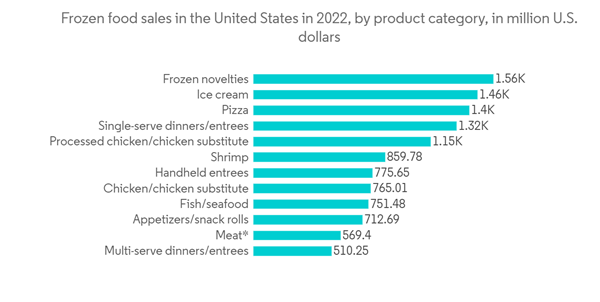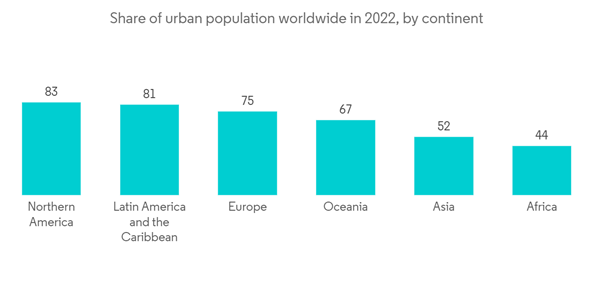In North America, the market for cold chain services is expanding rapidly. A shift in the region's eating preferences has been a fundamental driver of the cold chain business in North America.
As obesity rates rise and the incidence of lifestyle illnesses rises, consumers are increasing their consumption of proteins, vitamins, minerals, healthy fats, and so on while decreasing their carbohydrate intake.
This has accelerated the region's need for food goods such as meat, fruits, vegetables, and dairy products. Because these items are temperature sensitive, they must be kept and delivered in cold chains.
Consumers are increasingly looking for fresh, healthful, and locally sourced meals, and they are ready to pay a premium for high-quality goods. This has boosted the need for Food cold chain logistics services as businesses strive to ensure that their products reach consumers in the best possible condition.
The expansion of the e-commerce sector is another element fueling the growth of the US Food cold chain industry. As more people buy online, the need for cool chain logistics services has expanded, and businesses are working on ensuring that their items are delivered to clients effectively and on schedule. The import of exotic fruits and vegetables, along with the growing consumption of meat and poultry, has resulted in a rise of temperature-controlled warehouses, trucks, and other infrastructure to enable temperature-sensitive product delivery.
North America Food Cold Chain Logistics Market Trends
The rising consumption of frozen food
Frozen food businesses have responded successfully to customer interest by introducing products that are low in trans fat, low in fat, multigrain, whole wheat, and low in chemical preservatives. The North American frozen ready meals industry is primarily driven by increased demand for low-cost, high-quality, and fresh frozen pizza and portable breakfasts. Furthermore, the trend of eating out at restaurants and other culinary establishments is propelling the industry. According to the research, the North American area is one of the world's most important frozen food markets.People increasingly choose frozen fruits and vegetables, which allow them to enjoy even seasonal delights all year. The developments in cold chain infrastructure facilities across North America are driving this industry. In terms of country growth, the United States is regarded as the greatest income producer, followed by Mexico and Canada. The need for easy food products is the primary driver of the frozen food industry in North America since these foods minimize customers' cooking, preparation, and clean-up efforts and time.
The increased use of convenience foods such as RTE and RTC cut vegetables, mixed veggies, and meals as a result of consumers' busy lifestyles and stressful work schedules has increased demand for frozen vegetables in North America. Rising disposable income, urbanization, and changing lifestyles are all driving the market forward. Consumers increased spending power drives the demand for quality frozen vegetable goods. The growing trend of veganism is driving up demand for frozen veggies in North America. As a result of this tendency, many customers are becoming more reliant on fruits and vegetables, leading to a rise in demand for frozen veggies.
Growing urbanization and increased adoption of healthy lifestyle
Functional foods are foods that have been updated to aid in enhancing health. It does not cure the condition, but it can lower the chances of getting it. It feeds the body with essential nutrients like proteins and fibers. This allows the organs of the body to work appropriately and smoothly throughout the body. Simply said, functional foods in regular meals bring additional benefits to the health of any individual's body. The growing public awareness of the importance of good health has resulted in a major increase in the market acceptance of functional foods.DoorDash will partner with 18 cities – Mesa and Tucson in Arizona; Oakland and Riverside in California; Paterson and Camden City in New Jersey; Albany, Mt. Vernon, and Rochester in New York; Columbus, Ohio; Tacoma, Washington; Denver, Colorado; Hartford, Connecticut; Tampa, Florida; Atlanta, Georgia; Baltimore, Maryland; Pawtucket, Rhode Island; and Richmond, Virginia – to combat hunger by addressing transportation barriers to accessing healthy food. The company will provide targeted support through USD 1 million in DoorDash Community Credits, which community-based organizations can use to provide free food delivery; access to Project DASH on the DoorDash logistics platform, which food banks, food pantries, and other charitable organizations can use to power charitable food delivery; and direct funding of in-kind charitable food deliveries through the platform.
Google will launch new product features to help Americans access public food benefits and health care services. Google Search will facilitate SNAP enrollment by making it easier for users to find detailed and locally-specific information on how to check their eligibility and apply for SNAP benefits. Google will also update its search experience to enable Americans already enrolled in Medicare and Medicaid to find and schedule healthcare appointments directly within the Google Search tool.
North America Food Cold Chain Logistics Industry Overview
The North American food cold chain logistics market is highly fragmented, with a mix of global and regional players dominating the industry. Some of the key players in the market are Americold Logistics, Lineage Logistics (Preferred Freezer Services), Nichirei Corporation, Kloosterboer Group B.V., and VersaCold Logistics Services.The cold chain industry offers several possibilities for both new and established firms to penetrate regions with significant export potential as well as those with fast-expanding domestic demand for frozen goods. To gain a solid footing in the global market, these companies are increasingly turning to growth, mergers, and acquisitions.
Additional Benefits:
- The market estimate (ME) sheet in Excel format
- 3 months of analyst support
This product will be delivered within 2 business days.










